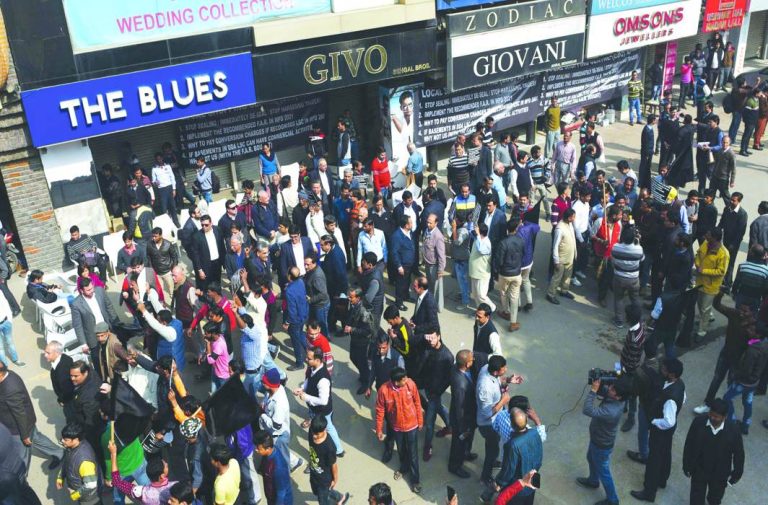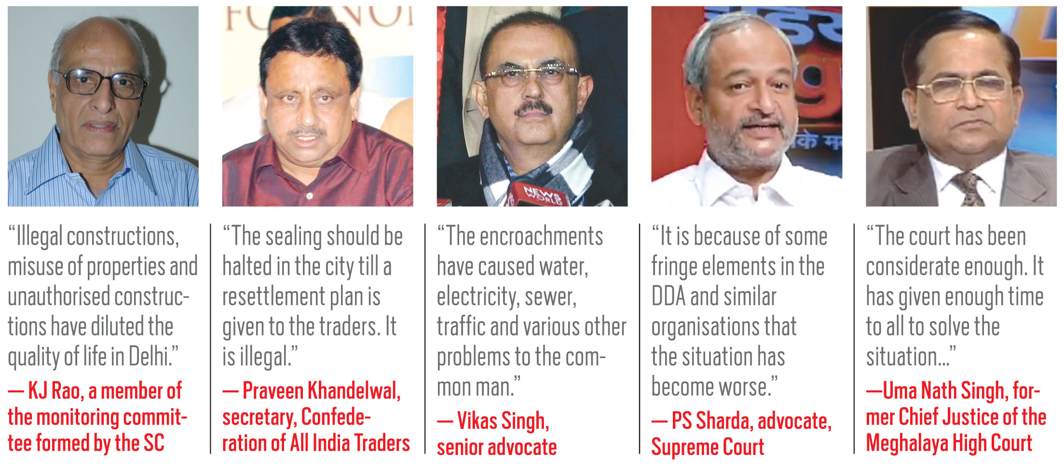
While the centre and the Supreme Court spar over the spread of illegal constructions, thousands of traders and workers have become jobless and homeless. What do experts say?
~By Usha Rani Das
The Supreme Court has come down heavily on the centre for failing to solve the issue of unauthorised constructions which have made Delhi an “unlivable place”. On April 4, 2018, a bench of Justices Madan B Lokur and Deepak Gupta said: “The people of Delhi are suffering; our children are suffering. Our lungs are already damaged. The lungs of our children will also be damaged. Why? Because the Union of India, the Delhi government, Delhi Development Authority and municipal corporations of Delhi say you can do whatever you want, but we will not do anything.”
The Supreme Court made the observations while hearing arguments on the Delhi Laws (Special Provisions) Act, 2006, that protects unauthorised properties from being sealed. The bench said: “It is a 30-year-old problem. The MCD (Municipal Corporation of Delhi) was granting licences left, right and centre without having any concern for anybody…There is gross misuse of commercial establishments in residential areas. The people of Delhi are not relevant to you.”
The Court also took the centre to task for a “complete breakdown of law and order” in Delhi as traders staged protests following the sealing of their shops and businesses. The sealing drive is against those who are using residential areas for commercial purposes and have not paid the conversion charge.
While the Court blames the centre, the latter is pleading for more time to come up with an alternative plan for resettlement of traders who have lost their homes and shops. Mukul Rohatgi, appearing for the centre, asked the Court on April 4 to give time to the authorities for rehabilitation.
Experts believe the situation cannot be solved so quickly as a nexus exists between politicians, bureaucrats, traders and MCD and DDA officials. Supreme Court advocate PS Sharda told APN: “This is not a recent drive. It went to the Supreme Court in 1990 for the first time. The Court said that the Delhi government is unwilling to take any action. The Court just asked them to implement their own laws. The DDA has its responsibility as well as the authority. Unfortunately, Delhi has become a gas chamber today. If there is a disaster, thousands more will be sacrificed because of the immaturity of some. The Court does not have vested interests in it… It is because of some fringe elements in the DDA and similar organisations that the situation has become worse.”
The sealing drive started initially in 2005 when the Delhi High Court sent a notice to the MCD to remove commercial construction in residential areas. This was followed by violent protests in the city that led to the deaths of four people. In March 2006, the Supreme Court ordered sealing of all unauthorised constructions in Delhi and appointed a monitoring committee to conduct the sealing drive. The then Congress-led government at the centre promulgated a law (Delhi Laws [Special Provisions] Act) to stop the sealing drive and made amendments to the Master Plan 2021 that gave respite to the traders as commercial and residential establishments could now function simultaneously in a restricted manner.
On December 15, 2017, the bench revived the powers of the monitoring committee after the reports submitted by it showed widespread unauthorised construction in Delhi. When asked the reasons for the long gap between the two sealing drives, ADN Rao, one of the lawyers who is amicus curiae in the case, told India Legal: “The legislation has been interfering in between.”

The centre had framed the Delhi Laws (Special Provisions) Act in 2006 to give protective cover for one year against sealing. But after 2007, it passed successive Acts and ordinances to extend the deadline and the last such law was passed by Parliament in December 2017 to protect illegal constructions till 2020. It said the government had passed the law in 2006, saying it needed to collect data on unauthorised constructions in Delhi but even after 12 years the centre had failed to carry out any survey.
KJ Rao, a member of the monitoring committee, told India Legal: “The problems are innumerable. Illegal constructions, misuse of properties, unauthorised constructions. It has diluted the quality of life in the city. The hearing is on April 9. Let’s see what happens.”
Former Chief Justice of Meghalaya High Court Uma Nath Singh told APN: “The Court has been considerate enough. It has given enough time to all to solve the situation…Hence they have revived the powers of the committee. As far as the human angle is concerned, why don’t the trader unions and associations stop traders from carrying out such illegal activities?”
Additional Solicitor General ANS Nadkarni, appearing for the centre, told the bench that the law was passed to grant relief to the poor living in unauthorised colonies and was not meant to override the SC’s judgment to initiate sealing. “The law was enacted on May 2006 to provide temporary relief to the people of Delhi against action for violation of the provisions of the Master Plan and building bye-laws for a period of one year to avoid hardship and loss to a large number of people. This was to enable the government to take a balanced and well-considered view on policies involving such unauthorised development so that the development of Delhi takes place in a sustainable and planned manner. It would also provide temporary relief to persons residing or carrying out commercial activities or otherwise dependent upon such unauthorised development,” he said.
“A substantial portion of the city population lives in slums/unauthorised colonies, therefore the government, being duty-bound to protect the poor, had to intervene on humanitarian grounds even as such inhabitants are encroaching on public or private land. It may be submitted that it was an emergent circumstance whereby people cannot be left to their fate as the unauthorised development that has happened was due to the failure of agencies to keep up with the growing demand. It is therefore imperative that the government frames policies for dealing with this unauthorised development for inclusive development of all sections in Delhi,” the centre said in its affidavit.
Thousands of shops in Khan Market, Sadar Bazar, Greater Kailash, Hauz Khas, Amar Colony, Gandhi Nagar, and so on, have been closed. Praveen Khandelwal, secretary of the Confederation of All India Traders, told India Legal: “The process of drafting the Master Plan for Delhi 2021-41 has started. The sealing should be halted till a resettlement plan is given to the traders. The MCD should only carry out sealing through the due process of law as has been specified in the MCD Act. The MCD Act states that before carrying out any raid, the municipal commissioner will file a complaint with the municipal magistrate, a notice would then be sent to those accused of any violation, they will respond to it and, following a hearing, the matter would first go to the appellate tribunal and then the lieutenant-governor. If the appeal is rejected, then sealing would be carried out. The sealing is illegal otherwise.” He also said that about six lakh traders of Delhi could be impacted by the sealing drive.
Rakesh Yadav, president of the Sadar Bazar Traders Association, told APN: “Young blood does not want to come and work here. There is no proper infrastructure, no safety, and hence, customers’ count has decreased over the years. The stay order was in 2006 but till now, no government official or any agency has come and discussed anything with us. There has been no development in the area yet.” Pradeep Gupta, president of the Gandhi Nagar Traders Association, accused the DDA of being corrupt.
Gaurav Chauhan, one of the lawyers representing the traders, told India Legal that previously one could go to the Appellate Tribunal MCD to file a case but under the current SC orders, once the shops are sealed, the aggrieved party has to approach the monitoring committee whereby he has to pay a fee of Rs 1 lakh. “How can a simple trader pay such a hefty amount?” he said.
An official of the monitoring committee, however, told India Legal: “Illegal constructions have become a menace to the city. It is degrading the quality of life. But what can we do? When our officials go on the spot, the traders protest and do not let us carry out the orders. What can even the police do when three or four of them are gheraoed by hundreds of people?”
Former IAS officer Capt Dwivedi said the public had been involved enough in the decision-making process. He told APN: “When the Master Plan was made, it was open to public discussions for quite a while. No one came forward then. The public was made well aware of the plan. It is true that these markets exist from the pre-Independence period. But the situation was different then. Shops which were 10×10 ft have increased to 10×22 ft. Eighty percent of the pavements has been encroached by these constructions.”
Senior advocate Vikas Singh said that municipal authorities don’t take any action when these illegal constructions start. He said: “And, when these people settle down, it becomes a human problem. Till you give an alternative space, where will these families go? The encroachments have caused water, electricity, sewer, traffic and various other problems to the common man.”
While the situation has boiled down to a fight between the centre and the apex court, it is the common man who is left in the lurch.



